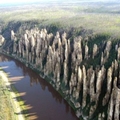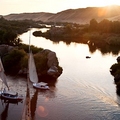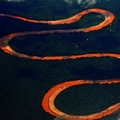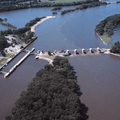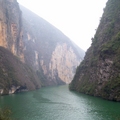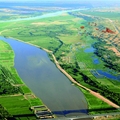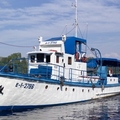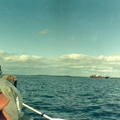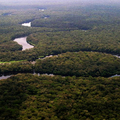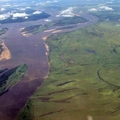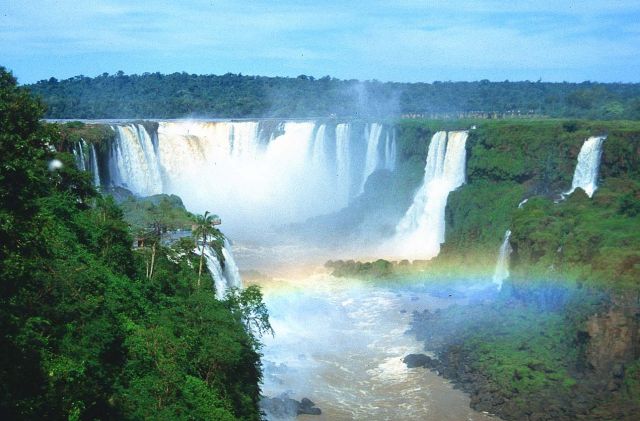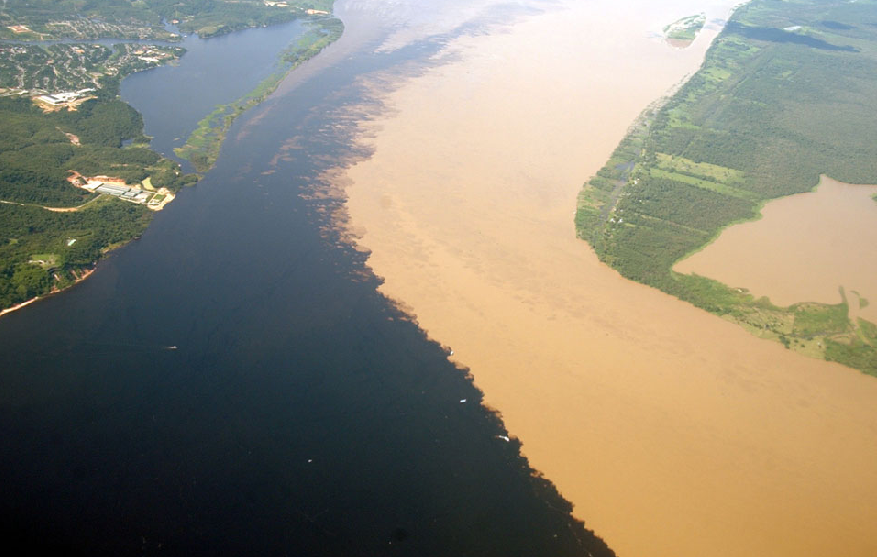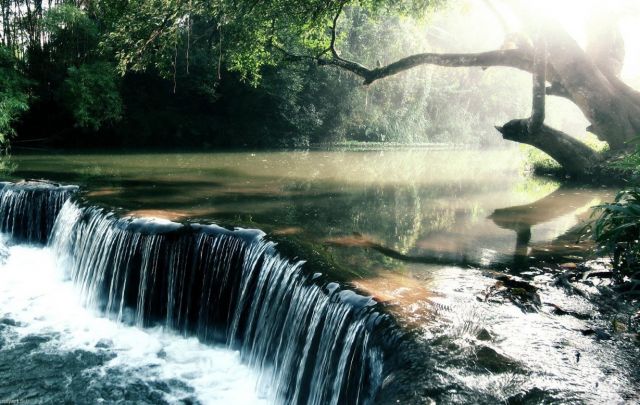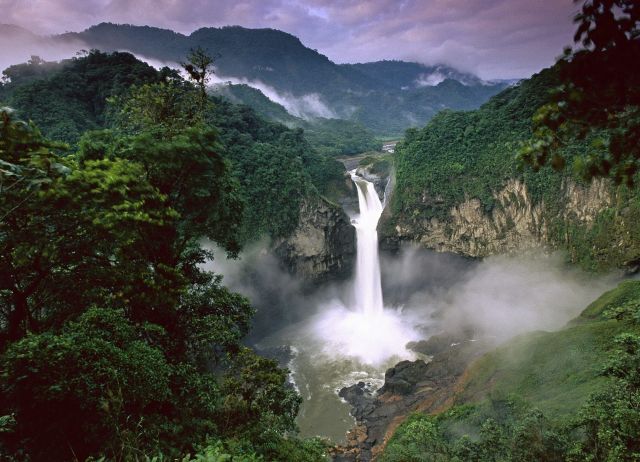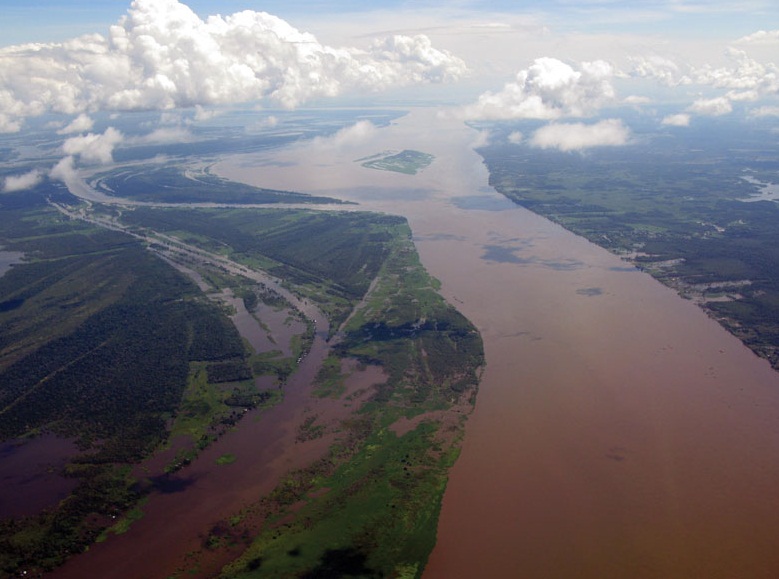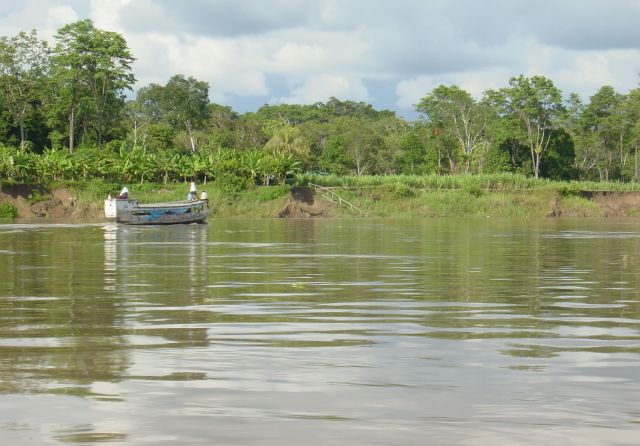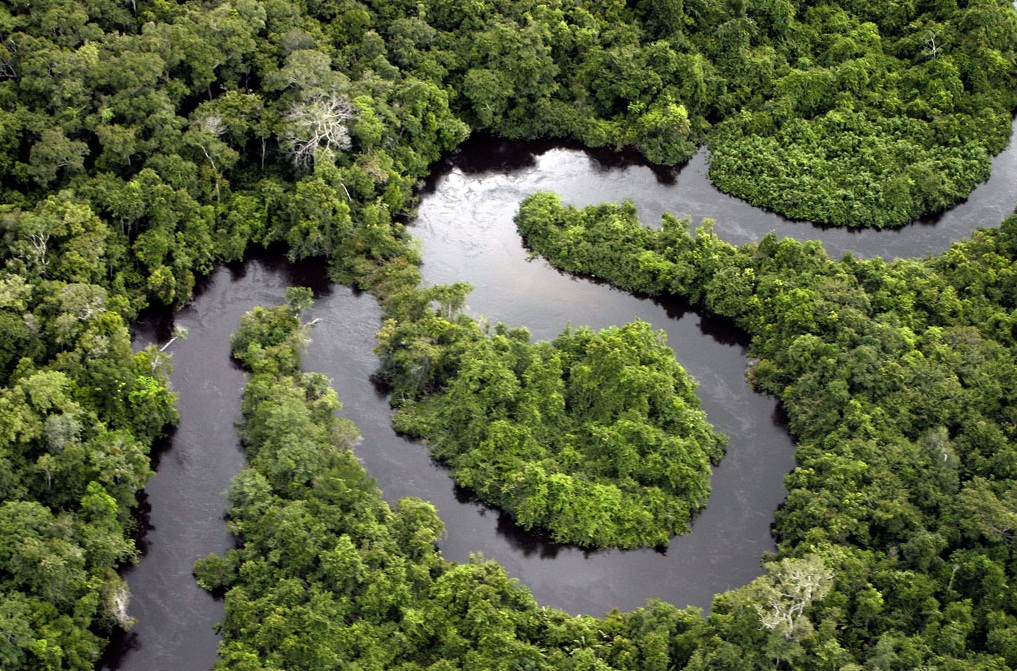Destinations / The Longest Rivers in the World / The Amazon River
The Amazon River
About Amazon
Amazon is a river in South America, the greatest and the largest in the world in its size, water content and length. The river is formed by the confluence of the rivers Marañón and Ucayali. The length of the main source of the Marañon is of 6437 km. Its source Apacheta is approximately 7000 km from the source of the Ucayali. The basin area is of 7180 sq km ² . Most of the Amazon belongs to Brazil, the south-western and the western areas belong to Bolivia, Peru, Ecuador and Colombia. Flowing mostly in the Amazon in the sub-latitudinal direction to the equator, the Amazon flows into the Atlantic Ocean, forming the world's largest estuary (an area of 100 thousand km ²). The Amazon’s harbor has numerous tributaries, about 20 of them are longer than 1500 km. The most important tributaries are on the right part of the river : Zhurua, Purus, Madeira, Tapajós, Xingu, Tocantins and Isa, Zhapura, Rio Negro are on the left part. The average consumption in the lower reaches is approximately of 220 000 m ³ / s ( but it varies by season from 70 to 300 thousand cubic meters per second). The average annual runoff is of about 7,000 km ³ (about 15% of the total annual flow of all rivers in the world). The solid stock is more than 1 billion tons. Tides penetrate up the river at 1,400 km . Together with its tributaries the Amazon forms a system of inland waterways with a total length of more than 25 thousand km. The mainstream of the Amazon is navigable for 4,300 km (to the Andes). To the city of Manaus (1690 km from the mouth) the ocean-going vessels rise up and offer spectacular views. The main ports are : Belém, Santarém, Obidus, Manaus (Brazil), Iquitos (Peru).
The history of the river
Francisco de Orellana was the first European to cross the South America at its widest part and discovered the river. In the summer of 1542 his unit allegedly saw the legendary tribe of Amazons, and engaged them in a battle. Today it is considered that this was a Native American woman who fought alongside men, or just long-haired Indians, whom the Spaniards took for women. Originally de Orellana wanted to call the river its name, but after the fight, he stopped at the version of "Amazon". Already in 1553 the name of the river Amazon was mentioned in the book " The Chronicle of Peru," by Cieza de Leon:
"But now opening up the river and found an amazing value, they seem more bays of the sea than rivers that flow along the ground. So is the fact than many of the Spaniards, the last with Adelantado Orellana , says that the river descends from Peru to the North Sea (the river is usually called the Amazons (de los Amazonas), or Maranon and has a length of more than a thousand leagues, and in width in some places more than 25. "The first printed work published on the journey through the Amazon was written by Cristóbal de Acuña.
Flora and fauna
Amazon has a surprising wealth of fauna and flora. A vast area is inhabited by more than one million various kinds of plants and animals, and this place is with no exaggeration to call the world's genetic stock. Scientists argue that a 10 km ² of rainforest has 1.5 thousand species of flowers, 750 species of trees, 125 species of mammals, 400 species of birds and countless insects and invertebrates. Many of their species is not even described or identified. The world's largest wet tropical forest stretches the basin of the Amazon river. This exclusive herbal natural formation was described by Alexander von Humboldt in his travels in South America in 1799-1804 years, calling it Gilea (from the Greek "gileston" - forest). The evergreen equatorial climate of the forest is hot and humid, all the year round the temperature ranges from 25-28 ° C, and even at night does not drop below 20 ° C. Rainfalls here are unusually abundant: their annual amount is of 2000-4000 mm, but sometimes it might be more. Inside the forest windless, but during the storm, treetops are swaying. Through the thick leaves and vines it might get little light, but the lush vegetation makes it difficult to move, completely depriving orientation. To move at even a short distance, you often have to hack.
The most typical of these places is an abundance of vines , thin, fast-growing stems, the length of which reaches 100 m. These plants entwine trunks and branches of trees, reaching NOK, where they find the light necessary for life, there they branch, they blossom and give fruit. You can climb on trees and hold on to help a variety of devices (whiskers, spines, thorns). The real miracle of the life of plants is the Victoria regia, the huge water lily. This plant is so strong that it can withstand the weight of a person. Near the river you can often find capybaras - the world's largest rodent ( its body weighs 50 kg), resembling guinea pigs. Animals coming to drink water, near the shore anaconda are the boas, the largest of snakes hunting in the water, which can stifle even the caiman.
The rich fauna of Amazonia is represented more by the freshwater river dolphin iniya and nutria (in Europe this animal is bred for fur farms). Around the shores of the Amazon the tapir can be seen too - a beautiful swimmer, although the weight of his body is of 200 kg. Most often he trails near the river alone. It feeds on leaves, twigs and fruits, many kinds of aquatic plants. One of the most dangerous and one of the most residents of the jungle are the cats: the jaguar who can even dive. The Guarani Indians called it “d'iaguar”.
The Amazon and its tributaries are home to over two thousand species of fish, a variety of shocking species. By the way, here comes a number of popular aquarium fish - such as guppies, swordtails and angelfish. It is home to the tambaqui fish, which feeds on the seeds falling into the water and the fruits of rubber trees. There are also protoptery - one of the last species on the Earth: dipnoi and arovana reaching a meter in length, which leap from the water and grab the beetle with overhanging branches over the water.
One of the most famous inhabitants of the Amazon are the piranhas, the small fish ranging in length from 13 to 40 cm, extremely voracious. They have a predatory lifestyle. They can attack even large animals (snakes, or mammals), crossing the river. They are dangerous for humans - attracted by the smell of blood, the swarms of these fish attack the prey, tearing chunks of meat with their teeth and biting the victim to the bone.
The largest forest of the planet
A very impressive part of mainland in South America is the world's largest lowland, which occupies about 5 million km 2 (more than half of Europe), which is equal to 9 countries. This lowland, Amazon got its name from the river running through it, the same name was all a gigantic natural area. A few decades ago it was completely covered with a single, largest forest on the Earth. Even today, when a significant part of the Amazon has lost vegetation, when the roads are built and the city, where many mining operations take place where they could grow trees, provokes an increasing felling. It still remains the largest forest planet. This humid tropical forest with more than a million species of plants and animals may be, with no exaggeration called the world's genetic stock. Even in the relatively small area, it has an astounding variety of 10 km2 of forest which contains up to 1,500 species of herbaceous plants, 750 different species of trees, 125 mammal species, 400 different species of birds, countless insects and other invertebrates. Many of the species living there still are not known to science. Scientists can only speculate about the true richness and the diversity of the natural resources of the tropical rain forest.
The Amazonian forest
Due to the immense size and due to the diversity of the natural conditions the Amazonian forests which grow here are different. By type of moisture they are divided into three main types: "white" woods (varzea), flooded in the rainy season, "black» (igapo), located on the marshy flood plains, and the "dry" wood. The flora and the fauna of the very different forest types differ substantially. The rivers often change the channel (only 30-40% of the territory has never been down the river), so that in the monotony at first glance of the forest it is difficult to find two similar plots. The "white" woods, located on the very fertile soils of the mountain streams bringing white silt, are precisely characterized by the most Ceiba, whose fruits can be found like a cotton fiber . These trees are so vividly described by Jules Verne in " The Children of Captain Grant. The supporting tall trunks of Ceiba dominate the understory of the tropical forests as a rock. The mahogany is still sometimes found or the pau brazil (the name of this plant is called in the name of the largest country in the continent), as well as the geveyu and the cocoa. The "Black" forests, by contrast, are growing strongly in the wetlands, deprived of oxygen, the soil less rich in vegetation and consists of breed well-adapted to such conditions . On the higher ground, which floods the river was during its frequent spills (called terra firma - firm ,that is reliable, earth). A mighty forest grows here. Most of the plants in it are completely unfamiliar to us. However, in the undergrowth you can often find all the well-known cocoa trees. Among the other most famous inhabitants of these forests, the giant giley dairy trees (a type of sweet juice like milk) can be mentioned and Castagno, whose fruits are known as Brazil nuts (these tasty and nutritious nuts in size and shape resemble the curved dates). Hence, also, originally, the Hevea rubber tree, as well as mogno, another famous mahogany, many palms, bromeliads (including pineapples), orchids and other epiphytes - 80 species of these "tenants" can be counted on the same tree.
It is interesting that the conservation of the tropical forests of Brazil is "the light" of the planet , not just for scientists. The festival for the support of the Fund for Saving the Rainforest was organized for more than ten years. The “Rainforest Foundation Benefit” involved one of the most famous composers and performers of the XX century: the British singer Sting. In addition to Sting other famous singers such as Elton John and Roger Taylor, a former member of the “Queen” take part in such festivals. In the forests of the Amazon Astronauts can see how the river continues its way to the Atlantic Ocean. Its course can be discerned at a distance of about 400 km from the coast. In the lower reaches of the Amazon sometimes spreads to 150 km, and at the mouth of the funnel - up to 230 km. Even if you go up the river up to 4000 km, its width is still the main channel ranging from 2 to 3.5 km, the depth is about 150 m, and the flow velocity reaches 10 - 15 km / h.
Amazon's amazing features
Only in the Amazon there is a unique natural phenomenon - a sharp rise in the water under the action of tides. A giant water wall up to 4 - 5 m - "pororoka" - with a frightening roar rushes up the river, sometimes getting to the areas located on the 1,400 km of the ocean. Some tributaries of the Amazon have a crystal-clear water of the highest peaks of the Andes, others - muddy tilled water with bare hillsides, soil erosion, which have undergone, and others - a clear, but painted in the color of strong tea water from the numerous swamps. One of the amazing features of the Amazon are the frequent spills and floods. Often, the water rises to 10-12 m, flooding vast areas. During the floods in the woods a complex branching system of ducts and countless lakes, creeks, ponds, swamps was formed. Therefore, the Amazon flora, consisting of nearly 3000 species of plants, includes a large number of the inhabitants of water, and the plants are well adapted to periodic flooding. During the severe flooding, striking pictures - sailing majestically down the river these islands with groups of trees, entwined with vines, covered with epiphytic orchids can be seen. Inhabitants of this piece of forest that have not had time to escape when the flood tore and undermined a part of the coast crowd on the islands. Streams of water rushing down the slopes of the Andes or from the Brazilian highlands, spreading the Amazon across the small and rather large animals, seeds and other plant parts can be seen too, so that there is "Migrations" and dispersal of plants.
Among the aquatic plants perhaps the most famous is Victoria, the world's largest water lily. The giant saucer leaves Victoria often reach almost 2 meters in diameter and freely bear the weight of a child. There are several species of this plant, although the most widespread is the Amazonian Victoria, but the first became famous for its close relative - the Royal Victoria, or Regia. When Victoria blooms at the botanical gardens there is really so rare that it becomes an event, reported by the local newspapers. Crowds of people come to admire the amazing flower, which remains uncovered three days. During these days, its color changes from snow white to pink, then the purple flower is fading.
The surface water in small creeks and in the main channel of the Amazon tributaries are often almost completely covered with a carpet of lush greenery and with a mass of purple-blue flowers: eyhornii. There is also another name for these seemingly harmless plants - water tent. The story of a dismal name, unfortunately, is quite common. A few decades ago eyhornii were brought to Florida, and in a few years shipping on most rivers of the peninsula became impossible. The long vines of the aquatic plants wound on the screws of motor boats and ships, prevented the move even of the small boats. But this was only the beginning. The "water plague", like its fearsome namesake, raging in the Middle Ages, spread rapidly along the rivers of North America, causing huge losses to navigation. Real panic began in Europe where the first floating islands eyhornii had been found. Fortunately, European harsh winters did not give the opportunity to continue their victorious march. In the U.S. A., it took many millions of dollars to spend and a lot of effort to cope with this "epidemy." One of the reasons why in South America, eyhornii do not make special problems, it is the presence of many herbivorous fishes and the beasts who peacefully "graze" in its thickets. Not for nothing one of these animals ate about 20 kg of plant per day, a manatee, which belongs to the water mammal dugong, or sirens (distant relatives of whales and seals), having also the name of "sea cow".
Manatees live in the sea and in the freshwater of Amazon. This is probably the largest river of mammals (beluga fish or a crocodile may be larger), the length of manatee sometimes exceed 2.5 m. . Piranhas have a formidable, scary reputation but only 4 of the 18 currently existing species are dangerous to humans. Even the black piranha, armed with such powerful and sharp as a razor teeth, that the Indians use it instead of the saw teeth, adheres to a vegetarian diet. But the carnivorous piranha, it's best not to mess with them. Piranhas can smell blood in the water for a considerable distance. Having received information that something appeared in the river, it has an incredible speed rushes to it. These fierce predators fall into such a frenzy that they even attack each other. The animal would be imprudent within reach, to be finished with it in minutes. One day was made a special experiment in the river water, swarming piranhas, threw the corpse of a 50 kg capybaras - the South American rodent, is very large, like a guinea pig. In 55 seconds it was completely eaten, and, gnawing meat from the ribs, these small fish bites them through. The most monstrous record was set in 1981, red piranhas, when near the town of Obidos in Brazil, an overloaded ferry sank and more than 300 people were eaten alive.
No less dangerous is the meeting with the giant Amazonian crocodile - caiman, enjoying as notorious as its relatives - the North American alligators. Caymans are more dangerous because they recognize the floating "logs" as difficult. These animals are true masters of camouflage, they often move in the "wreaths" of water hyacinth on the head. These many amazing animals can be found only in the Amazon and the list of the exotic inhabitants of the great river can continue and continue.
Thus, the river is one of the most amazing places in the world, irreplaceable in size, displaying original vegetation and many animal species diversity. While in Brazil or Peru, you can have one of the most fantastic cruisers along the river and see many animal species with your own eyes, many beautiful, enchanting natural views which will enchant your eyes, by no means.
Others The Longest Rivers in the World .
Maps of The Amazon River
map BrazilOthers from The Longest Rivers in the World
Everyone dreams to visit at least one of these places.
Those who live in modern cities with tall buildings tend to lose what Mother Nature has to offer.
They say "beauty is in the eye of the beholder," and there are probably many places that you consider to be most important in the world.
To our mind, rivers are very important and they offer splendid, natural views that Mother Nature offers.
Water is one of the most precious natural resources , we cannot live without it.
Globally, water supplies are rare: less than 1% of the world's water is good for consumption, and much of it, 2/3 of the Earth’s surface is covered by rivers and salt waters.
A river is formed from the union of several streams which naturally flow downhill , under the effect of gravity , which either flows into another stream or river ( its tributary ) or in a lake , a sea or an ocean .
For this reason we do not pretend that our list of places included are the most beautiful, but rather among the vast collection of the longest and the largest rivers in the world.
1 - Nile - 6600 km, the most beautiful areas of the basin downstream waterways are in Aswan.
2 - Amazon - 6480 km, the largest river basin in the world, cruises are up to Iquitos.
3 - Yang Tse Kiang - 6300 km downstream from the dam cruises.
4 - Mississippi - 6280 km, one in four Americans living around the pool's third largest river in the world, every city on its banks proposes at least one cruise.
5 - Yenissei - 5540 km, navigable by small portions, is the longest in Russia.
6 - Huang He (Yellow River) - 5464, with most cruises in China.
7 - Ob Irtchych - 5410 km, one of the 120 rivers that cross Russia.
8 - Congo - 4800 km, the second largest river basin in the world that flows, in sequence with Amazon, African adventure for the brave.
9 - Amur - 4500 km, navigable river, it crosses Russia and China.
10 - Lena - 4400 km, the most eastern of Russian rivers, crosses Siberia from the south to the north and it is one of the most fascinating deltas.
For the lovers of amazing sceneries, these rivers can be the perfect destinations and the cruises the most wonderful experiences.
Cruises have always aroused the curiosity of people even if not everyone can afford such a trip.
If the desire to live new sensations, schedule your vacation early next year and choose a destination that allows you to take a cruise on one of the longest rivers in the world.

